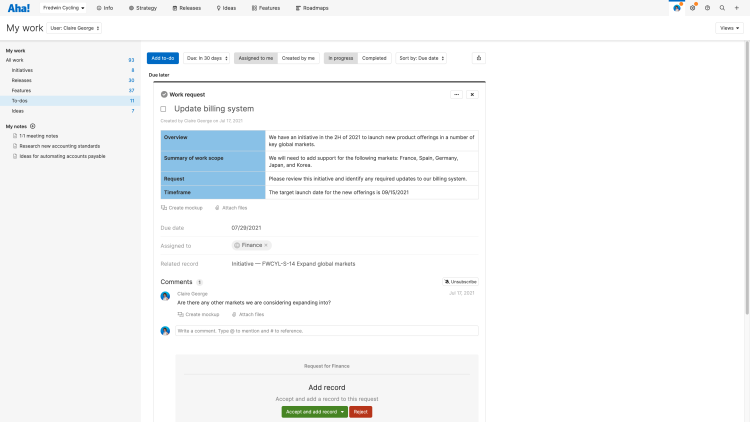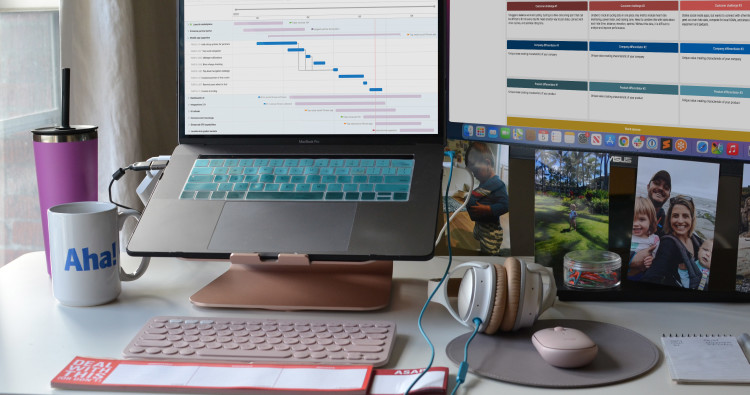
A New Way to Request Work From Other Cross-Functional Teams
Dependencies. They often lead to nightmares for product managers. We all have had them. Whether you are launching a new product or an enhancement to an existing one, you need to bring together the right teams to deliver an exceptional customer experience. But how do you request that work from other teams? And how do you keep everyone accountable and in sync? It can be tricky to coordinate — especially if you do not have visibility once you send a request. Not any more.
You can now assign work requests to other teams in Aha! Roadmaps and automatically track cross-functional dependencies.
Work requests are ideal for tracking cross-team work. You can create a request within the to-dos tab of a record — such as a goal, initiative, release, epic, feature, or requirement — and assign the request to another team's workspace. This way, the receiving team can review what is needed and accept, reject, or ask for more information.
When a team accepts a request, the next step is for them to create their own record to capture and track what is needed. This action automatically establishes a dependency between the records in both workspaces — so everyone is aligned.
Creating work requests is particularly useful for organizations where teams span multiple business units and functions. This is why it is available to customers on our Enterprise+ plan. This plan is ideal for teams that demand the most sophisticated capabilities and a hands-on level of support. Our Enterprise+ plan also includes advanced security and backup features as well as ongoing consultation. Please contact us if you would like to learn more.
Note that you must enable work requests in the security and single sign-on section in your account settings to start using it. Once enabled, all user roles can create a work request and assign it to any workspace in your account. Only workspace owners and contributors can accept or reject requests.
Let's take a closer look at sending and receiving work requests:
Initiate a work request
Imagine you have a strategic initiative to launch a new product offering. This is a major investment that requires help from the broader company — including finance, legal, and marketing. Create a work request for each team, describe what you need, and assign it to their workspace. In the example below, we created a request for the finance team to update the billing system with new pricing information.
When you create a to-do, you will see there are three types — a regular to-do, approval, or a work request.
Review incoming requests
Now let's look at the workflow from the perspective of the team receiving the request. Here, we are using the same billing system example. Anyone who is an owner or contributor in the finance team's workspace will see the request in the to-dos section of their My work page. This makes it easy for the team to review new requests and decide whether to accept them.

Use comments to gather additional information needed to scope the work.
Move work forward
Let's go ahead and accept the request. We add an epic to update the billing system so the team can prioritize the work. A dependency is automatically established between the new feature and the original initiative. This automation ensures that everyone can move ahead with clarity about what needs to be done and when.
To accept a request, you must create an initiative, epic, or feature.
Automatically track dependencies
Keep track of the work by viewing the related tab in both records. This gives everyone clear visibility into the status of cross-functional dependencies. Open the drawer view for more details and add a comment to proactively share updates.

You can also create a dependency report to review the status of all work.
Take a new approach to managing cross-team requests — no more chasing down work to ensure you deliver on time.
Building teams that move fast and work well together differentiates market leaders from those who lose time to misalignment and disorganization. Get streamlined and give the new work request functionality a try. You will love how easy it is to keep everyone in sync and on schedule.
Upgrade to the Aha! Roadmaps Enterprise+ plan
Aha! Roadmaps is the best way to set strategy, prioritize features, and share visual plans. Choose the Enterprise+ plan if you need the most sophisticated capabilities, advanced levels of support, security and backup features, as well as and ongoing consultation. Please contact us if you would like to learn more.




